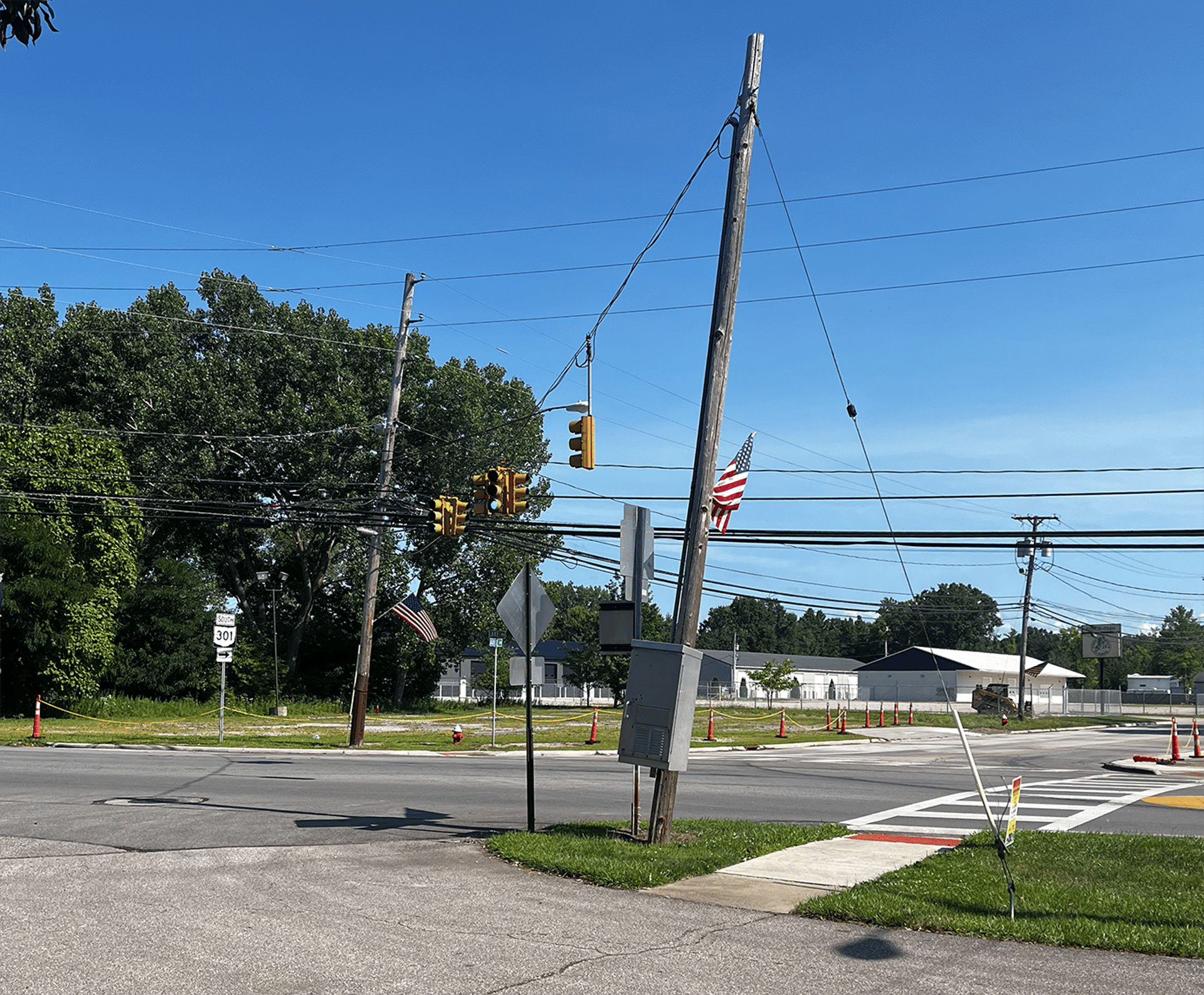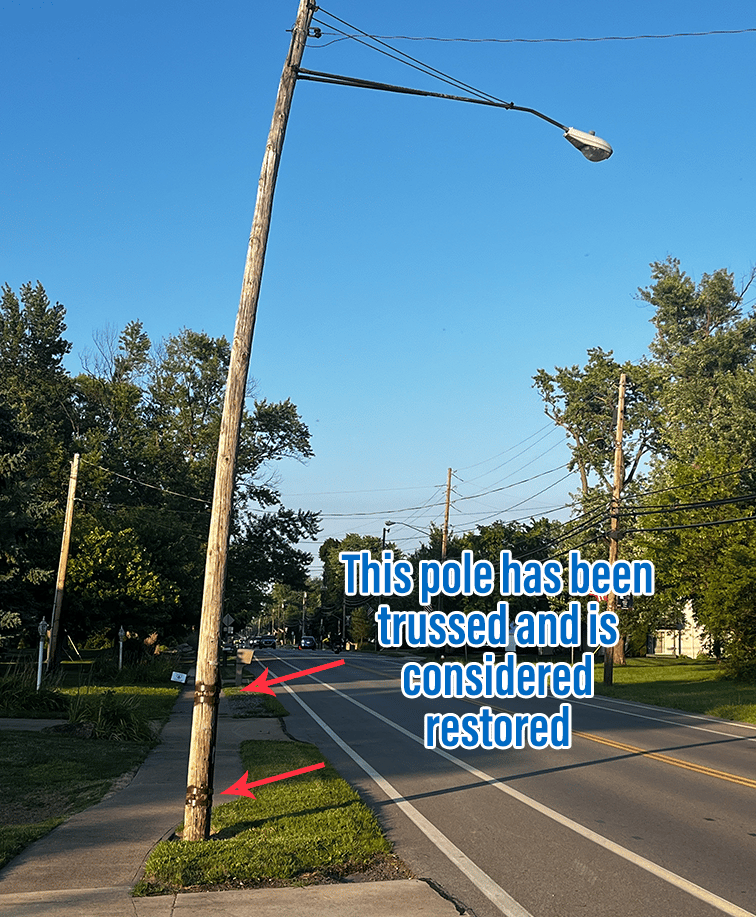
Is this Community Pride?


We need city officials to take action.
We cannot continue to let First Energy take advantage of our community. Their dereliction of the proper maintenance of utility poles is profoundly egregious and so systemic that it needs to be addressed on a city-wide basis. If a city can fine a resident for not mowing their lawn they can fine a utility company for not keeping their poles straight.


When a contractor "restores" a pole - it is industry standard first to straighten it. The company doing the "restoration" programin Sheffield Lake has failed to adhere to industry standards.
When a pole has been restored, the utility company considers its present condition to last for at least another 25 years.
Restored poles are the poles that have a metal truss inserted into the ground and extend 4 feet to 5 feet above the ground and are then banded with two sets of bands.
According to the policies of the competitors of First Energy - any pole leaning 10 degrees or more is considered an emergency. Poles leaning 3 degrees but less than 10 degrees are flagged for straightening. Typically a utility pole is straightened by a boom truck and a structural expanding foam such as polecrete is poured around the pole.
When utility poles lean, it can lead to significant issues with the lines they support, including sagging or excessive tension. Here’s why this is a problem:
Sagging or Overly Tight Lines
Sagging Lines: A leaning pole can cause power lines to sag, making them more susceptible to damage. Sagging lines can droop closer to the ground, posing a safety hazard and increasing the risk of accidental contact. For instance, a semitruck may come down your street and knock down your power, internet, or cable television connections.
Overly Tight Lines: Conversely, a leaning pole can stretch the lines too tightly. This excessive tension can weaken the wires, making them more prone to snapping under stress.
Wind and Torque
Increased Torque: When the wind catches sagging wires (this happens especially when the wires are covered in ice), it can cause them to sway. This swaying motion generates torque, putting additional stress on both the lines and the poles. Leaning poles are less stable and more susceptible to this torque, increasing the risk of failure.
Ice Accumulation: In cold weather, ice can form on the lines, adding extra weight. This exacerbates the problem of sagging lines. The additional weight from ice can make the lines sway even more in the wind, generating enough torque to cause the wires to snap.
Impact of Constant Strain
Long-term Stress: A leaning pole causes constant strain on power lines. Over time, this continuous stress weakens the lines, making them more likely to fail, especially under severe conditions like extreme cold or heavy ice accumulation.
Risk of Power Outages: The combination of these factors—leaning poles, sagging or tight lines, wind-induced torque, and ice accumulation—creates a high risk for power lines to snap. When lines snap, it can lead to power outages, affecting homes and businesses and potentially causing dangerous situations.
Addressing leaning utility poles promptly is crucial to maintaining the integrity of the power grid. Ensuring that poles are upright and secure helps prevent the strain and torque that can lead to snapped lines and power outages. Regular maintenance and proactive repairs are essential to avoid the cascading effects of leaning poles on the electrical infrastructure.
This a volunteer effort to identify the shoddy workmanship performed by utility pole restoration contractors.
As poles are identified they will be placed on the map in as timely as manner as possible. We hope to document as many poles as possible and submit them to First Energy, the Public Utilities Commission of Ohio, and to Sheffield Lake's city council and mayor. Identified poles are marked with a purple lightning bolt icon. You can report a leaning or rotting utility pole by clicking on the button below the map. We hope that we can get utility poles repaired before we have a big ice storm or blizzard.
Legal Basis:
“Subject to the requirements of Section 1 of Article V of this constitution, municipalities shall have authority to exercise all powers of local self-government and to adopt and enforce within their limits such local police, sanitary and other similar regulations, as are not in conflict with general laws.”
Ohio Revised Code 715.27(A)(2) “Regulate the construction and repair of wires, poles, plants, and all equipment to be used for the generation and application of electricity;”
Ohio Revised Code 715.44 (A) “ Abate any nuisance and prosecute in any court of competent jurisdiction, any person who creates, continues, contributes to, or suffers such nuisance to exist;” -leaning and poorly maintained utility poles can be considered a nuisance when they impact property values or become a hazard or a danger.
Ohio Revised Code 723.01 “...the legislative authority of a municipal corporation shall have the care, supervision, and control of the public highways, streets, avenues, alleys, sidewalks, public grounds, bridges, aqueducts, and viaducts within the municipal corporation….” - which includes the authority to regulate structures on these public grounds such as utility poles.
(Q) “Utility pole" means a structure that is designed for, or used for the purpose of, carrying lines, cables, or wires for electric or telecommunications service. "Utility pole" excludes street signs and decorative poles.”
(O) "Public way fee" means a fee levied to recover the costs incurred by a municipal corporation and associated with the occupancy or use of a public way.
(J) "Occupy or use" means, with respect to a public way, to place a tangible thing in a public way for any purpose, including, but not limited to, constructing, repairing, positioning, maintaining, or operating lines, poles, pipes, conduits, ducts, equipment, or other structures, appurtenances, or facilities necessary for the delivery of public utility services or any services provided by a cable operator.
(N) "Public way" means the surface of, and the space within, through, on, across, above, or below, any public street, public road, public highway, public freeway, public lane, public path, public alley, public court, public sidewalk, public boulevard, public parkway, public drive, public easement, and any other land dedicated or otherwise designated for a compatible public use, which, on or after July 2, 2002, is owned or controlled by a municipal corporation. "Public way" excludes a private easement.
(A) If a public utility does not accept a public way fee levied against it pursuant to the enactment of an ordinance by a municipal corporation, the public utility may appeal the public way fee to the Public Utilities Commission. The appeal shall be made by filing a complaint that the amount of a public way fee, any related classification of public way occupants or users, or the assignment or allocation of costs to the public way fee is unreasonable, unjust, unjustly discriminatory, or unlawful. The complaint shall be filed not later than thirty days after the date the public utility first becomes subject to the ordinance. The complaint is subject to the same procedures as a complaint filed pursuant to section 4905.26 of the Revised Code. The commission shall act to resolve the complaint by issuance of a final order within one hundred twenty days after the date of the complaint's filing.
(B) Only upon a finding by the commission that reasonable grounds are stated for a complaint filed under division (A) of this section, the commission by order shall suspend the public way fee provisions of the municipal ordinance for the duration of the commission's consideration of the complaint. For the purpose of this division, if the commission so suspends an ordinance pursuant to a complaint filed not later than thirty days after the date that the ordinance first takes effect, the suspension shall apply to the public way fee for every occupancy or use of the public way to which the fee would otherwise apply. For any other complaint, the suspension shall apply only to the public utility filing the complaint. The municipal corporation may later collect, for the suspension period, any suspended public way fee only if the commission finds that the public way fee is not unreasonable, unjust, unjustly discriminatory, or unlawful.
Can the City of Sheffield Lake regulate the disposition of its utility poles? Can the City fine a utility company for being out of compliance with a municipal code for Utility Poles?
The Sheffield Lake Forum
Paid for by the committee - For a Better Tomorrow - Elect Jon Morrow
Text or call
"We all win when we make our voices heard!"
(419) 602-4425
© 2025. All rights reserved.


Disclaimer
The website www.SheffieldLake.community is both a work of irony and a platform of ideas.
It playfully satirizes the hypersensitivities of those who zealously defend Mayor Rocky Radeff’s policies, while earnestly offering real-world proposals for improving life in Sheffield Lake.
This site serves two purposes:
To highlight, through gentle parody, the contradictions and overreactions that too often dominate local discourse, and
To present serious, forward-looking solutions for residents to evaluate and discuss.
While its tone occasionally employs humor and irony, the underlying intent is civic — to inform, challenge, and inspire thoughtful conversation about the future of our city.
Authorized and maintained by Jon Morrow, Councilman-Elect, Ward 1, City of Sheffield Lake.
